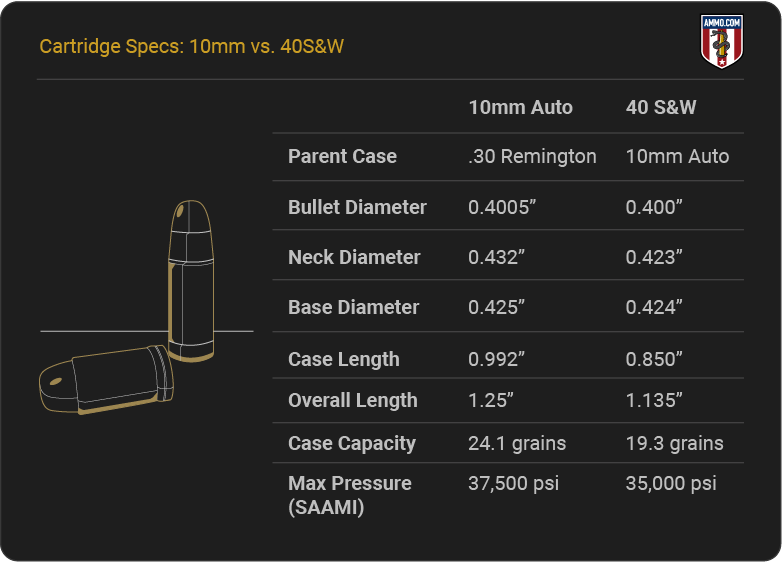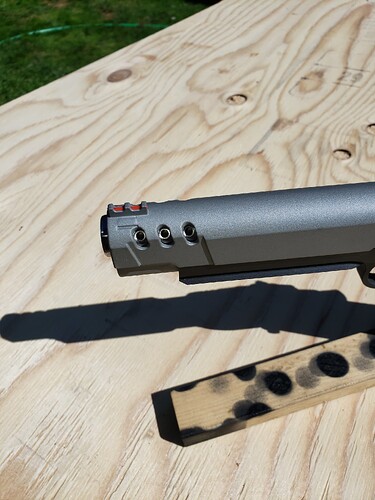When we compare the two cartridges on paper, the 10mm should blow the 40 S&W out of the water. Lt. Col. Jeff Cooper designed the 10mm to exhibit better external ballistics than the 45 ACP, and the 40 Smith & Wesson was intentionally designed by weakening the 10mm.
But there might be better choices than the 10mm for you for various reasons. We’ll compare these two cartridges based on their recoil, trajectory, accuracy, stopping power, effectiveness in self-defense, cost and availability, and reloading potential.
Continue reading to discover if the 10mm Auto is supreme – or if you should use a 40 Smith & Wesson instead!
10mm vs. 40
The 10mm was created to exhibit better terminal ballistics (i.e. penetration and expansion) than the 9mm Luger, as well as better external ballistics (i.e. effective range and muzzle velocity) than the 45 Automatic Colt Pistol.
The 40 S&W is a reduced power load based on the 10mm. It was developed in 1990 by Smith & Wesson and Winchester as a rimless, centerfire handgun cartridge to meet the FBI’s requirements for an effective defense round.
How do these two cartridges compare? Let’s begin with their specs.
Cartridge Specs
Since the 40 S&W was developed from the 10mm Auto, we should expect many similarities and a few significant differences in terms of the cartridges’ specifications.
These two rounds’ bullet diameter, neck diameter, and base diameter are virtually identical to the naked eye (the 40 S&W base diameter is 0.001” narrower than the 10mm, and the neck diameter of the 40 is 0.009” narrower than the 10mm).
The .40 cal’s shorter case also means it is slightly shorter overall and has a lower case capacity than the 10mm, leading to a lower maximum pressure.
While these two rounds are visually distinct, they can be easily confused at the range. If you’re firing both cartridges during the same range day, keep them separate to prevent a catastrophe.
Let’s see how the visual differences equate to real-world performance.
Recoil
Bullet weight, firearm weight, muzzle velocity, and propellant weight determine how much recoil a cartridge generates. There is never an apples-to-apples comparison between any cartridge or caliber. That said, we can provide a general idea of how much felt recoil to expect while firing these rounds.
The average 10mm Auto 180 grain load has around 11.5 ft-lbs (foot-lbs) of recoil. To rifle shooters, this doesn’t sound like much, but that’s 50% more recoil than the 45 Auto( another comparable handgun cartridge).
The average 40 S&W 180 grain load has a little over 5.1 ft-lbs of recoil. In other words, the .40 S&W generally has less than half of the amount of recoil of the 10mm.
While some shooters do consider it a little snappy, recoil-sensitive individuals should go with the 40 S&W over the 10mm.
The .40 Smith & Wesson takes an early lead because it has less recoil than the 10mm Auto, allowing for more accurate follow-up shots as it will have less muzzle flip, making it much easier to remain on target or quickly get back on target.
Trajectory
Since most self-defense situations happen within 25 yards, the trajectory doesn’t matter all that much, as both calibers will remain relatively flat shooting at that distance.
However, the 10mm is often used for handgun hunting. In this instance, you will likely need to fire over distances greater than 25 yards, which necessitates careful consideration of bullet drop.
The 10mm has the advantage, as it has a flatter trajectory than the 40 S&W, simply because it’s more powerful.
Continue reading 10mm vs. 40 S&W: Which Cartridge Is Better? on Ammo.com!










